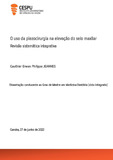| dc.contributor.advisor | COSTA, JOSÉ ADRIANO FERREIRA GOMES DA | |
| dc.contributor.author | Jeannes, Gauthier Erwan Philippe | |
| dc.date.accessioned | 2022-11-07T11:51:03Z | |
| dc.date.available | 2022-11-07T11:51:03Z | |
| dc.date.issued | 2022 | |
| dc.identifier.uri | http://hdl.handle.net/20.500.11816/4083 | |
| dc.description.abstract | Introdução: O seio maxilar é uma estrutura anatómica com proximidade aos dentes. Com a idade e perda de peças dentárias, o volume do osso diminui, provocando uma reabsorção da maxila e levando assim a uma pneumatização secundária do seio. A fim de resolver o problema da perda óssea, é possível elevar o soalho do seio maxilar e realizar um enxerto ósseo, evitando danos sobre a membrana de Schneider e tecidos vizinhos. Embora existam diferentes técnicas de osteotomia, hoje em dia, os instrumentos ultrassónicos e piezocirurgia são cada vez mais usados.
Objetivos: Analisar as aplicações da piezocirurgia ao nível da elevação do seio maxilar, estudando a técnica, vantagens e desvantagens desta cirurgia, em comparação aos métodos tradicionais.
Materiais e métodos: Foi realizada uma pesquisa na base de dados PubMed através de palavras-chave. Foram encontrados 717 artigos e, após processo de seleção através de critérios de inclusão e exclusão, foram escolhidos 22 artigos, e 13 artigos foram encontrados com pesquisa manual para este estudo.
Resultados: Foi observado que o sistema de piezocirurgia é complexo e que a irrigação é indispensável. No entanto, parece realizar corte ósseo de forma mais suave, sem aquecimento, através de uma boa irrigação. Além disso, as estruturas aparentam ser preservadas, evitando danos. Adicionalmente, o conforto do paciente durante o pós-operatório é satisfatório.
Conclusão: A osteotomia com sistema piezocirurgia aparenta ser uma boa alternativa às técnicas convencionais. | pt_PT |
| dc.description.abstract | Introduction: The maxillary sinus is an anatomical structure with proximity to the teeth. With age and loss of the dental piece, the volume of the bone decreases, causing a re-absorption of the maxilla, leading to a secondary pneumatisation of the sinus. In order to solve the problem of bone loss, it is possible to lift the floor of the maxillary sinus and perform a bone graft avoiding damage to the Schneider's membrane and the neighbouring tissues. There are different osteotomy techniques. Nowadays, ultrasonic instruments, piezosurgery are used more and more.
Objectives: To study its applications in terms of maxillary sinus elevation, studying the technique, advantages and disadvantages of this surgery in comparison with traditional methods.
Materials and methods: A search was conducted in the PubMed database with keywords. A total of 717 articles were found after a selection through inclusion and exclusion criteria, 22 articles were chosen, and 13 articles were found with manual search for this study.
Results: It was observed that the piezosurgery system is complex and irrigation is indispensable. However, it seems to have a smoother bone cut without heating due to good irrigation. Moreover, structures seem to be preserved and damage avoided. Finally, the postoperative patient comfort is satisfactory.
Conclusion: Osteotomy with piezosurgery system seems to be a good alternative to conventional techniques. | pt_PT |
| dc.language.iso | por | pt_PT |
| dc.rights | info:eu-repo/semantics/openAccess | pt_PT |
| dc.subject | Piezosurgery | pt_PT |
| dc.subject | Sinus floor augmentation | pt_PT |
| dc.subject | Maxillary osteotomy | pt_PT |
| dc.title | O uso da piezocirurgia na elevação do seio maxilar Revisão sistemática integrativa | pt_PT |
| dc.type | info:eu-repo/semantics/masterThesis | pt_PT |
| dc.identifier.tid | 203081366 | pt_PT |
| thesis.degree.name | Mestrado em Medicina Dentária | pt_PT |

